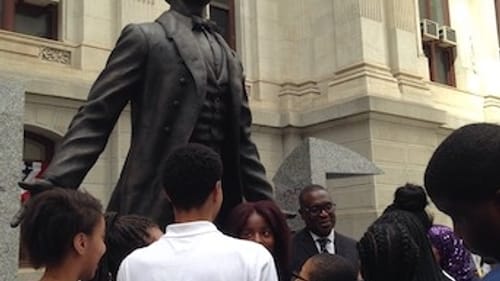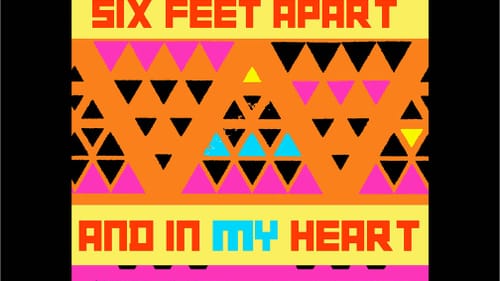Stay in the Loop
BSR publishes on a weekly schedule, with an email newsletter every Wednesday and Thursday morning. There’s no paywall, and subscribing is always free.
Not a cut. A collapse.
Will we let the City of Philadelphia defund the arts because of the pandemic?

Mayor Jim Kenney’s proposed 2021 budget for the City of Philadelphia, revised from a pre-pandemic March 5 proposal, makes one response to our city’s crisis clear: eliminate arts, culture, and special events. In a civic and financial road map that grapples with who faces this crisis, and how, the why of our survival is severed and bleeding.
“Funding for the arts, special events, and nonprofit support will be reduced or eliminated,” the proposal’s intro states. This includes significant funding cuts to the Philadelphia Museum of Art and the Mural Arts Program. And the total elimination of the city’s Office of Arts, Culture, and the Creative Economy (OACCE).
If you’ve ever read BSR, this affects you too—we’re a nonprofit publication celebrating our 15th anniversary this year, and a significant portion of our operating dollars come from the Philadelphia Cultural Fund. Supporting hundreds of diverse Philly arts groups, the Fund would be gutted with the loss of OACCE.
We’re facing a lot of questions—including the reality of what we propose to reduce, instead of chopping off the arts. We look forward to a vital citywide conversation about this—as impassioned, contentious, and creative as Philly itself.
“Safe, healthy, educated”
To cope with punishing losses in tax revenue and a crush of public-health needs, the proposed budget brings pain in many sectors. This includes increased taxes, widespread layoffs, and pay cuts; and cancellations, deferrals, or downsizing on everything from library and parks programming to violence prevention to scholarships.
The new proposed budget states three priorities: keeping Philadelphians “safe,” “healthy,” and “educated.”
“This targeted approach considered the impacts of each decision and did not assume that all departments would take the same level of reductions,” the proposal states. The fact that some departments will immediately be hit harder than others is not news to anyone in the arts and culture sector, who are always forced to staunch the wound first, even in lesser crises.
More than a cut
It’s worth checking the visual. The budget document is full of columns of numbers showing modest to severe decreases between 2020 and 2021, but the OACCE is one of very few showing not a cut, but a collapse to a row of zeros. According to the budget, eliminating OACCE saves the city about $4.4 million—less than 0.7 percent of the city’s entire projected shortfall of $649 million in 2021.
Why does the arts sector matter? Our economy, for one. In 2017, a comprehensive report from the Philadelphia Cultural Alliance found that our arts and culture sector has an economic impact totaling $4.1 billion, returning $1.3 billion to the community in the form of household income and generating more than $224 million in local and state tax revenue.

Justice in budgeting?
To its credit, the new proposed budget cites as a “guiding principle” the need to make decisions “through a lens of racial equity,” noting that people of color have already suffered “decades” of discrimination and are at disproportionate risk from COVID-19.
But if there’s anything the arts shows me, it’s that my own knowledge of injustice, when left to traditional social and educational structures, is tragically inadequate.
For example, I didn’t know that the legal battle over Japanese American internment in the US reached my own lifetime until I saw a 2015 production of Jeanne Sakata’s play Hold These Truths. A few years later, a screening of Resistance at Tule Lake through the Japanese Americans Citizens League schooled me further, as did an exhibition about anti-Asian propaganda, part of the Art in City Hall program (which would also die with OACCE).
Thanks to Philly performer Eppchez !, I learned that despite generations of erasure, trans and agender people have been forces of history for centuries.
I first learned about Philly civil-rights giant Octavius Catto at a Fringe show several years ago, and understood more after the city installed a monument dedicated to him in 2017.
An artists’ workshop was the first time I really grasped the principles of universal design, why it doesn’t apply only to people with disabilities, and why accessibility isn’t just a benefit, but a necessity.
How can we build social equity while defunding one of the prime ways we create and access crucial stories for, by, and about people of color, immigrants, LGBTQ people, people with disabilities, and so many others? I feel sharply embarrassed to admit everything I didn’t know before the arts turned on the light. How does eliminating the arts keep Philadelphians “educated”?
The art of health
You also can’t separate keeping Philadelphians “healthy” from arts and culture. We socialize and keep active through everything from walking tours to readings. Just last fall, the Mütter Museum launched an eerily prescient march and exhibition highlighting the flu pandemic of 1918-19. Anybody see a lesson there now?

Mural Arts, which made us into “the City of Murals” and now stands to lose more than 20 percent of its current support from the city, jumped into action on the public-health front. This includes a facemask-making project, and work with Broad Street Ministry and other partners on temporary installations that promote tips for staying healthy in the pandemic—alongside handwashing stations accessible to the people who need them most.
Mural Arts also teamed with the Philadelphia Department of Public Health to launch the Space Pads project, providing eye-catching floor markers to local stores, to ensure that shoppers keep a safe distance from each other. One, designed by artist Shira Walinsky, reads: “Six feet apart and in my heart.” In one look, it reminds us not only to stay distanced, but why we must do so—because we care for other people—and that our separation is physical, not emotional.
And afterward?
It might take months or years, but this pandemic will subside. If we destroy our government funding structure for arts and culture in the meantime, we might have a guide for how some version of this World Heritage City will emerge. But we aren’t cogs in a city machine. We’re human beings with a million bridges to build—through theater and film and music, stories and books, poems and paintings and processions. It’s not just how we’re fighting to overcome this pandemic. It’s why.
Readers who care about independent arts journalism are helping us overcome a major potential funding loss that will affect our whole sector. Make a donation to BSR here.
If you want to save Philly’s Office of Arts, Culture and the Creative Economy, sign the petition.
Sign up for our newsletter
All of the week's new articles, all in one place. Sign up for the free weekly BSR newsletters, and don't miss a conversation.

 Alaina Johns
Alaina Johns